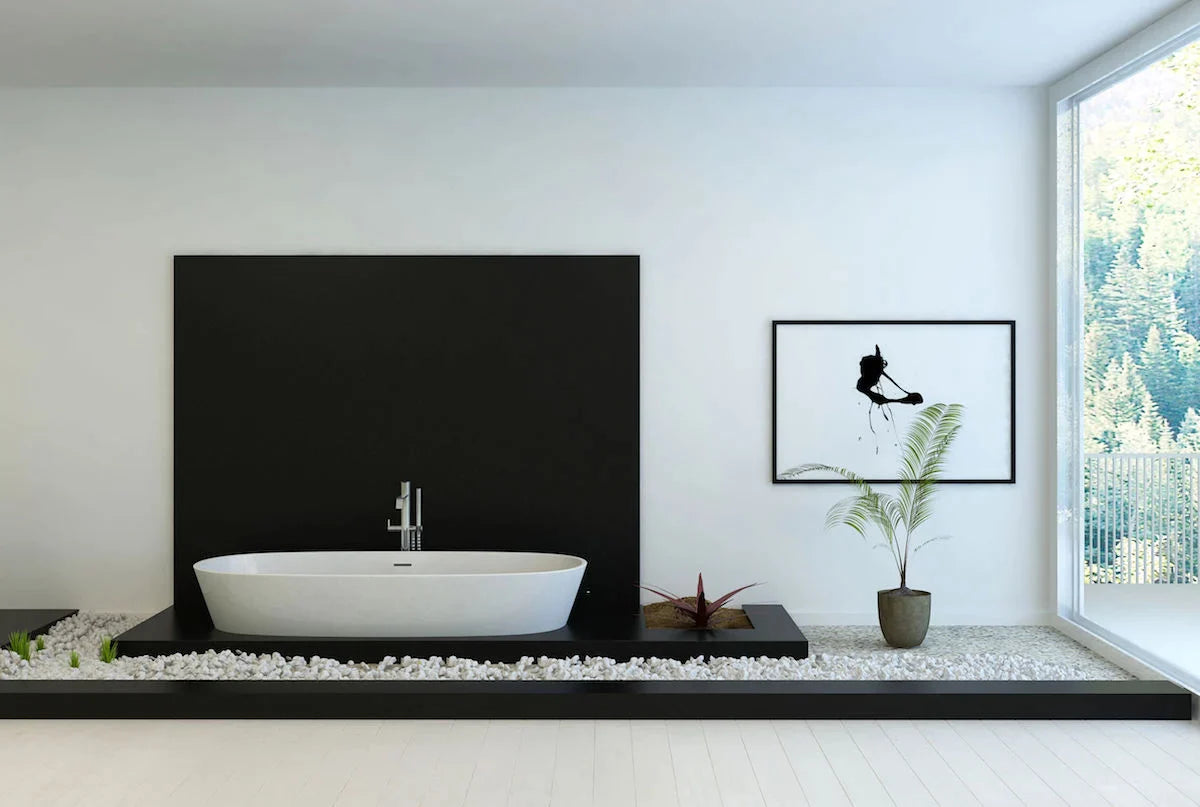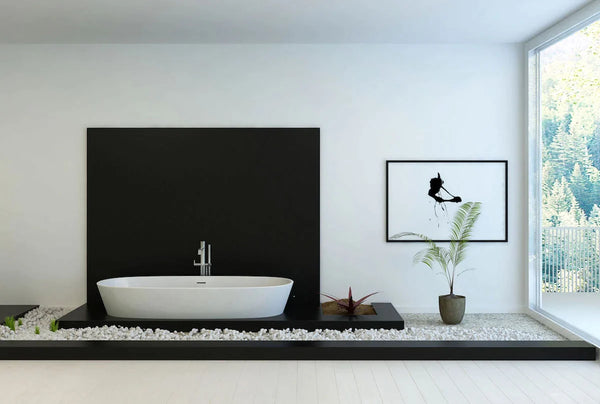The bathroom is a personal place typically designed to invoke peace and calm. For this reason, we’re used to painting this space in whites, neutrals and soothing cool colors.
In contrast, recent trends feature black as a primary color choice. Whether it’s shiny dark marble, black fixtures or midnight paint color, there are so many ways to incorporate black into the bath. Here’s why you should consider this approach — and how to do it right.
Why Should You Choose a Black Bathroom?
If you’re toying with the idea of designing with black, you should think of the impact that this look would have on your home. As explained in the men’s magazine Next Luxury, incorporating black into your bathroom invites a sophisticated note into your entire home. “For those who view the bathroom as a retreat and chance at some well-won luxe pampering, black lends some serious metropolitan edge to an otherwise innocuous necessity.”
Kelsey Kloss at Elle Decor agrees. She points out that black bathrooms, while dramatic, are also elegant. They add an unmistakably masculine touch to the space too, which is a departure from the either utilitarian or somewhat feminine look that relies on whites and neutrals. And while it’s a bold choice, black doesn’t have to be moody or depressing. Instead, black bathrooms should take a nod from art deco and modern styles to create something timeless and inviting.
In fact, one of the greatest benefits of incorporating black into the bathroom is that black detail stands out instantly. A small addition makes a big impact. The design choice makes the bathroom feel sleek and exciting, rather than grim, because it’s unexpected. More prosaically, fingerprints don’t show on black fittings, adds the team at retailer Island Bathrooms. And watermarks are hard to see on black tiles and panels too. So in addition to being bold and beautiful, black bathroom elements make the area easier to clean and maintain.
Simple Black and White
While monochromatic bathroom design is certainly in style, black walls and fixtures have to be balanced. One way to achieve this is to opt for a traditional black and white color scheme, with an emphasis on the black.
There’s a black and white bathroom designed by Vancouver-based interior designer Chrissy Cottrell that serves as a great example. On one hand, the look is fairly simple, with smooth black walls and all white flooring and fixtures. However, subtle gold touches and marble floor detail give the space a boost of overall elegance that elevates the average black and white combination.
Another approach to black walls and a white tile floor can be seen in the apartment of design curator and vintage collector Kate Rheinstein Brodsky. The black walls aren’t painted, but instead covered in Saint Laurent marble, which has streaks of gray and a slight reflective quality. She makes use of chrome and brass touches to bring in more brightness. These touches, along with the tall mirrors around the vanity, help bounce natural light and give the black walls a burnished look.

Black Patterns and Textures
One key to designing with black at a large scale is to leverage pattern. Black patterned tiles, for example, can work well with bathrooms that feature either a dominant black or a black and white color scheme. A black and white tile floor can look beautiful in contrast with a white freestanding tub and half black walls, as showcased by Samantha Bacon of the Making Your Home Beautiful blog.
At the same time, these tiles can be used for an all white bathroom where the only instance of black is in industrial-inspired black fixtures and accents around the mirror.
Black walls can also compliment textures, such as those found in wood. This is a more unique approach to black bathrooms, because they’re usually paired with white or light shades. Pairing them with dark wood tones enhances the moody and dramatic feel of the space, explains Lauren Smith at House Beautiful.
This scheme works particularly well in bathrooms with tubs, creating an enveloping feeling that’s equal parts classy and cozy. Plus, a light-filled window and gilded mirror can add a touches of bright glam to the space.
To see how texture can enhance a mostly black bathroom, visit this home created by interior designer Becki Owens. One bathroom wall is made of bricks, the rough material hand painted in a semi-gloss black. Notice too how the bricks are placed vertically, giving the illusion of height.

Black Patterns in the Bathroom
Patterns are a smart and sophisticated way to add more pizzazz to the bathroom while keeping a black and white scheme balanced and inviting.
In an elegant art deco bathroom featured by Vicky Lowry at Elle Decor, black floors are balanced with unique black and white marble that brings an exciting pattern to the bathroom. This luxurious bathroom features marble layers and textures along with black and white-based marble slabs. As a result, it creates a more intriguing look than ordinary flush tile slabs, enhancing the art deco look.
Those seeking to add black in a more subtle way can leverage black patterns as well. Adding patterns to cabinet doors, for example, can draw the eye to the black in the room without using it as a primary design color. Bathroom vanity doors adorned with a black and white zebra pattern are a non-intrusive way to add black to the bathroom, as shown by Homedit. The black accents are further balanced with a light marble countertop and white mounted porcelain sink.
A large-scale art print can assume a similar role. In a home designed by Virginia-based NF Interiors, a black and white bathroom is given an artistic uplift thanks to the accent wall in the shower. The abstract print hints at something from the east, yet it is made modern with polished chrome accents and contrasting floor and ceiling tiles.
Black Bathroom Accents
To place slightly less emphasis on the black and use it instead as an accent color, consider this design by Annie Hall Interiors. She chose to make the black vanity and mirror the statement pieces of the room. This was achieved by balancing busy black and white wallpaper with sleek, modern black furniture. A touch of greenery shows how natural elements, such as plants or wood accessories, compliment the bold black and white theme nicely.
Black accents were also incorporated into this design from David Charlez Designs. The master bathroom features black accent walls in the doorway and behind the vanity, as well as on the vanity drawers. These elements are balanced with two white walls, a marble-clad shower and a marble floor. The glass door of the shower also helps with this balance, as it makes the white marble in the shower more visible and increases the white surface area in the space.
Images by: skdesign/©123RF.com, Praurat Fhunta, Katarzyna Białasiewicz/©123RF.com







